start stop button Hyundai Equus 2013 Owner's Manual
[x] Cancel search | Manufacturer: HYUNDAI, Model Year: 2013, Model line: Equus, Model: Hyundai Equus 2013Pages: 479, PDF Size: 10.15 MB
Page 17 of 479
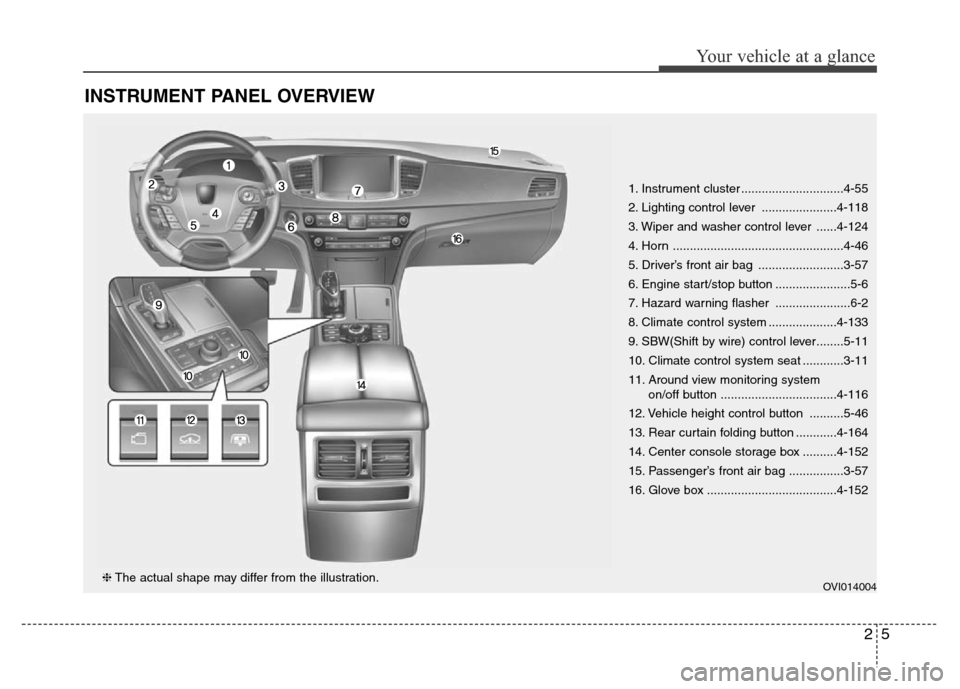
25
Your vehicle at a glance
INSTRUMENT PANEL OVERVIEW
1. Instrument cluster ..............................4-55
2. Lighting control lever ......................4-118
3. Wiper and washer control lever ......4-124
4. Horn ..................................................4-46
5. Driver’s front air bag .........................3-57
6. Engine start/stop button ......................5-6
7. Hazard warning flasher ......................6-2
8. Climate control system ....................4-133
9. SBW(Shift by wire) control lever........5-11
10. Climate control system seat ............3-11
11. Around view monitoring system
on/off button ..................................4-116
12. Vehicle height control button ..........5-46
13. Rear curtain folding button ............4-164
14. Center console storage box ..........4-152
15. Passenger’s front air bag ................3-57
16. Glove box ......................................4-152
OVI014004❈The actual shape may differ from the illustration.
Page 23 of 479
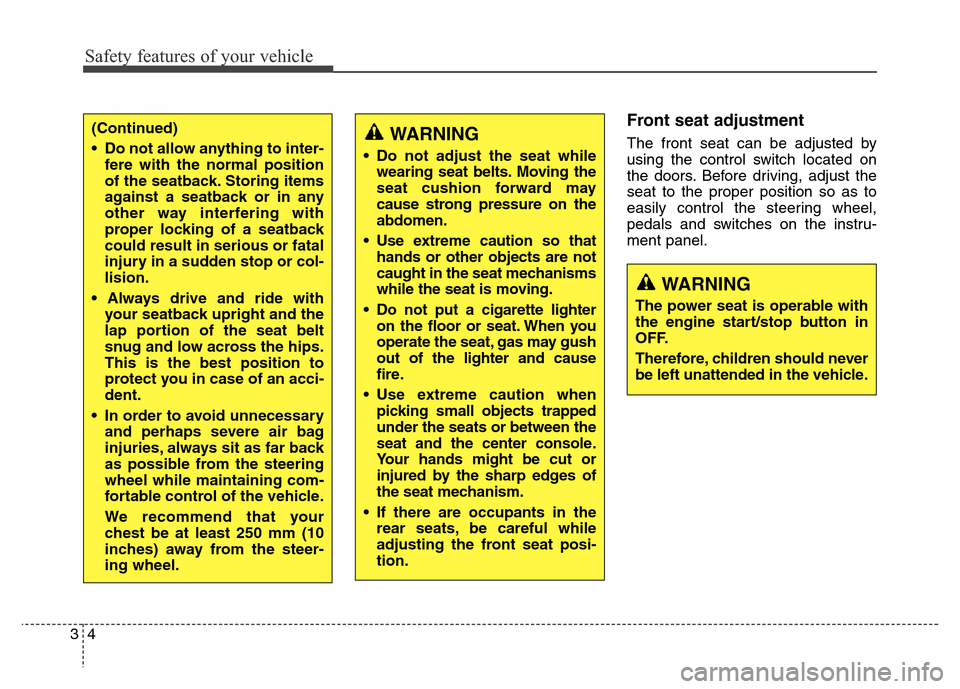
Safety features of your vehicle
4 3
Front seat adjustment
The front seat can be adjusted by
using the control switch located on
the doors. Before driving, adjust the
seat to the proper position so as to
easily control the steering wheel,
pedals and switches on the instru-
ment panel.WARNING
• Do not adjust the seat while
wearing seat belts. Moving the
seat cushion forward may
cause strong pressure on the
abdomen.
• Use extreme caution so that
hands or other objects are not
caught in the seat mechanisms
while the seat is moving.
• Do not put a cigarette lighter
on the floor or seat. When you
operate the seat, gas may gush
out of the lighter and cause
fire.
• Use extreme caution when
picking small objects trapped
under the seats or between the
seat and the center console.
Your hands might be cut or
injured by the sharp edges of
the seat mechanism.
• If there are occupants in the
rear seats, be careful while
adjusting the front seat posi-
tion.
(Continued)
• Do not allow anything to inter-
fere with the normal position
of the seatback. Storing items
against a seatback or in any
other way interfering with
proper locking of a seatback
could result in serious or fatal
injury in a sudden stop or col-
lision.
• Always drive and ride with
your seatback upright and the
lap portion of the seat belt
snug and low across the hips.
This is the best position to
protect you in case of an acci-
dent.
• In order to avoid unnecessary
and perhaps severe air bag
injuries, always sit as far back
as possible from the steering
wheel while maintaining com-
fortable control of the vehicle.
We recommend that your
chest be at least 250 mm (10
inches) away from the steer-
ing wheel.
WARNING
The power seat is operable with
the engine start/stop button in
OFF.
Therefore, children should never
be left unattended in the vehicle.
Page 29 of 479
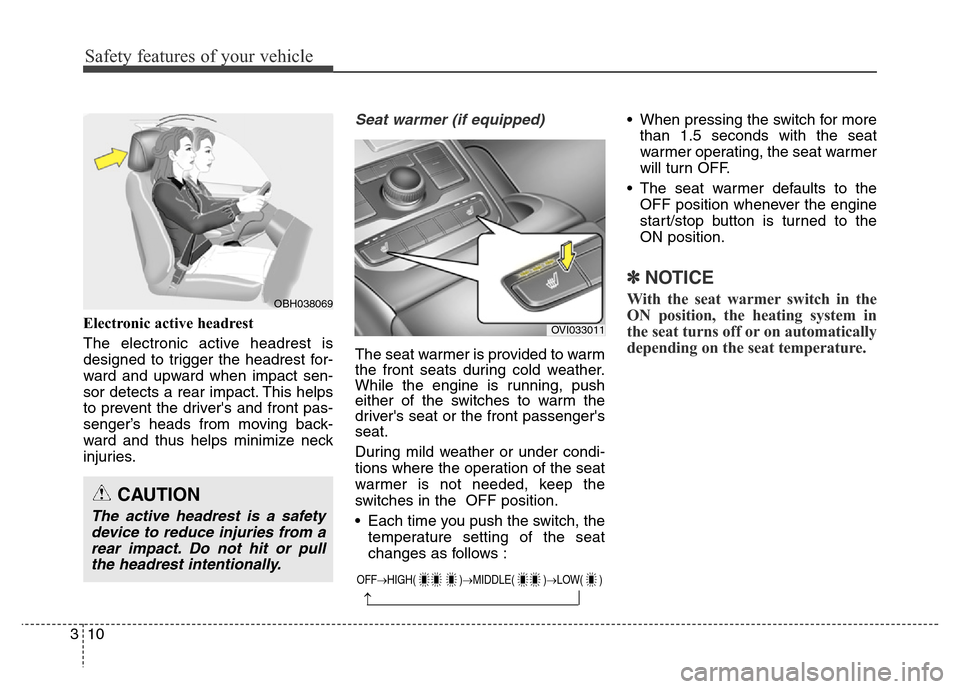
Safety features of your vehicle
10 3
Electronic active headrest
The electronic active headrest is
designed to trigger the headrest for-
ward and upward when impact sen-
sor detects a rear impact. This helps
to prevent the driver's and front pas-
senger’s heads from moving back-
ward and thus helps minimize neck
injuries.
Seat warmer (if equipped)
The seat warmer is provided to warm
the front seats during cold weather.
While the engine is running, push
either of the switches to warm the
driver's seat or the front passenger's
seat.
During mild weather or under condi-
tions where the operation of the seat
warmer is not needed, keep the
switches in the OFF position.
• Each time you push the switch, the
temperature setting of the seat
changes as follows :• When pressing the switch for more
than 1.5 seconds with the seat
warmer operating, the seat warmer
will turn OFF.
• The seat warmer defaults to the
OFF position whenever the engine
start/stop button is turned to the
ON position.
✽NOTICE
With the seat warmer switch in the
ON position, the heating system in
the seat turns off or on automatically
depending on the seat temperature.OBH038069
CAUTION
The active headrest is a safety
device to reduce injuries from a
rear impact. Do not hit or pull
the headrest intentionally.
OVI033011
OFF→HIGH( )→MIDDLE( )→LOW( )
→
Page 31 of 479
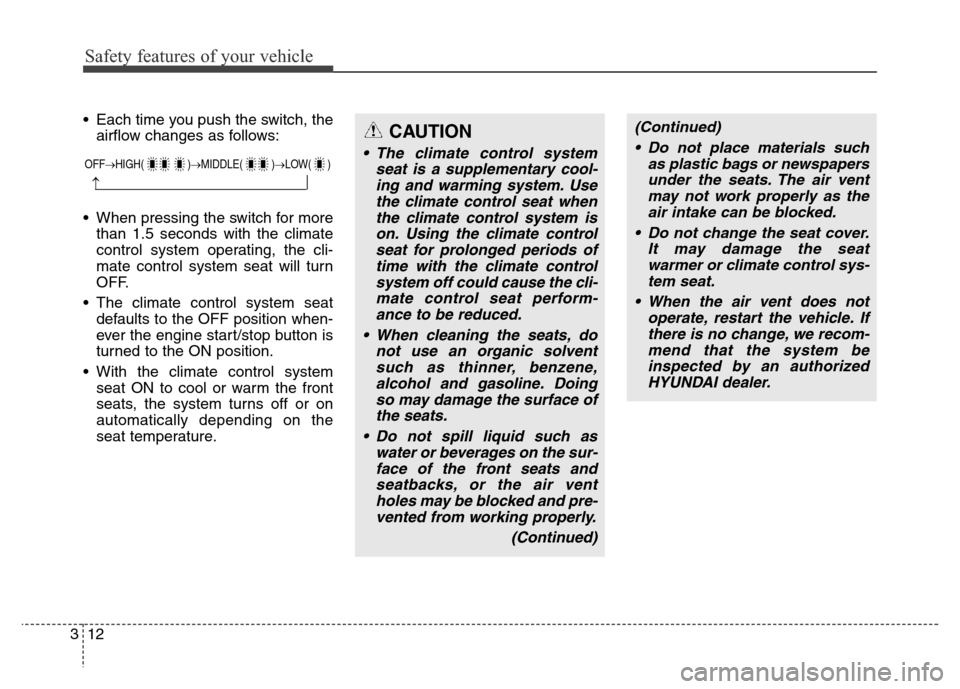
Safety features of your vehicle
12 3
(Continued)
• Do not place materials such
as plastic bags or newspapers
under the seats. The air vent
may not work properly as the
air intake can be blocked.
• Do not change the seat cover.
It may damage the seat
warmer or climate control sys-
tem seat.
• When the air vent does not
operate, restart the vehicle. If
there is no change, we recom-
mend that the system be
inspected by an authorized
HYUNDAI dealer.• Each time you push the switch, the
airflow changes as follows:
• When pressing the switch for more
than 1.5 seconds with the climate
control system operating, the cli-
mate control system seat will turn
OFF.
• The climate control system seat
defaults to the OFF position when-
ever the engine start/stop button is
turned to the ON position.
• With the climate control system
seat ON to cool or warm the front
seats, the system turns off or on
automatically depending on the
seat temperature.
OFF→HIGH( )→MIDDLE( )→LOW( )
→
CAUTION
• The climate control system
seat is a supplementary cool-
ing and warming system. Use
the climate control seat when
the climate control system is
on. Using the climate control
seat for prolonged periods of
time with the climate control
system off could cause the cli-
mate control seat perform-
ance to be reduced.
• When cleaning the seats, do
not use an organic solvent
such as thinner, benzene,
alcohol and gasoline. Doing
so may damage the surface of
the seats.
• Do not spill liquid such as
water or beverages on the sur-
face of the front seats and
seatbacks, or the air vent
holes may be blocked and pre-
vented from working properly.
(Continued)
Page 32 of 479
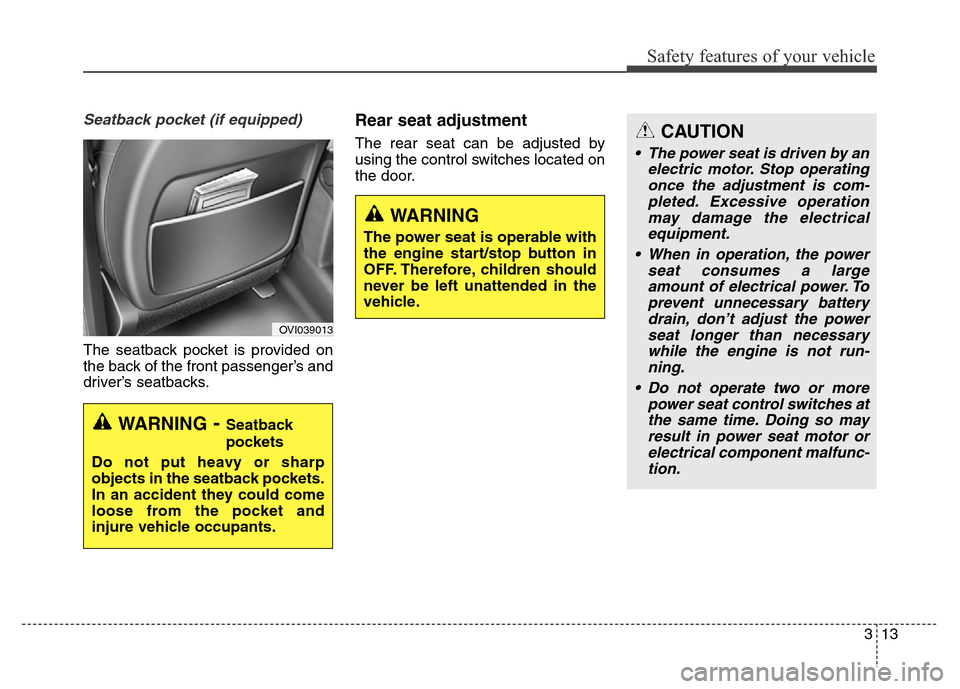
313
Safety features of your vehicle
Seatback pocket (if equipped)
The seatback pocket is provided on
the back of the front passenger’s and
driver’s seatbacks.
Rear seat adjustment
The rear seat can be adjusted by
using the control switches located on
the door.
WARNING- Seatback
pockets
Do not put heavy or sharp
objects in the seatback pockets.
In an accident they could come
loose from the pocket and
injure vehicle occupants.
OVI039013
WARNING
The power seat is operable with
the engine start/stop button in
OFF. Therefore, children should
never be left unattended in the
vehicle.
CAUTION
• The power seat is driven by an
electric motor. Stop operating
once the adjustment is com-
pleted. Excessive operation
may damage the electrical
equipment.
• When in operation, the power
seat consumes a large
amount of electrical power. To
prevent unnecessary battery
drain, don’t adjust the power
seat longer than necessary
while the engine is not run-
ning.
• Do not operate two or more
power seat control switches at
the same time. Doing so may
result in power seat motor or
electrical component malfunc-
tion.
Page 44 of 479
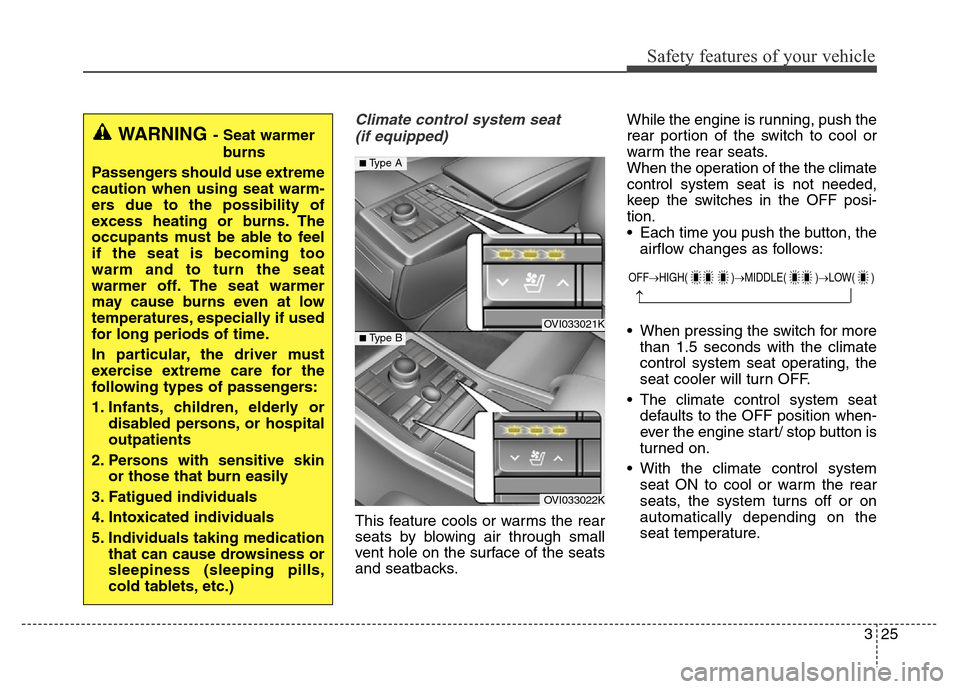
325
Safety features of your vehicle
Climate control system seat
(if equipped)
This feature cools or warms the rear
seats by blowing air through small
vent hole on the surface of the seats
and seatbacks.While the engine is running, push the
rear portion of the switch to cool or
warm the rear seats.
When the operation of the the climate
control system seat is not needed,
keep the switches in the OFF posi-
tion.
• Each time you push the button, the
airflow changes as follows:
• When pressing the switch for more
than 1.5 seconds with the climate
control system seat operating, the
seat cooler will turn OFF.
• The climate control system seat
defaults to the OFF position when-
ever the engine start/ stop button is
turned on.
• With the climate control system
seat ON to cool or warm the rear
seats, the system turns off or on
automatically depending on the
seat temperature.
WARNING- Seat warmer
burns
Passengers should use extreme
caution when using seat warm-
ers due to the possibility of
excess heating or burns. The
occupants must be able to feel
if the seat is becoming too
warm and to turn the seat
warmer off. The seat warmer
may cause burns even at low
temperatures, especially if used
for long periods of time.
In particular, the driver must
exercise extreme care for the
following types of passengers:
1. Infants, children, elderly or
disabled persons, or hospital
outpatients
2. Persons with sensitive skin
or those that burn easily
3. Fatigued individuals
4. Intoxicated individuals
5. Individuals taking medication
that can cause drowsiness or
sleepiness (sleeping pills,
cold tablets, etc.)
OVI033021K
OVI033022K
■Type A
■ Type B
OFF→HIGH( )→MIDDLE( )→LOW( )
→
Page 48 of 479
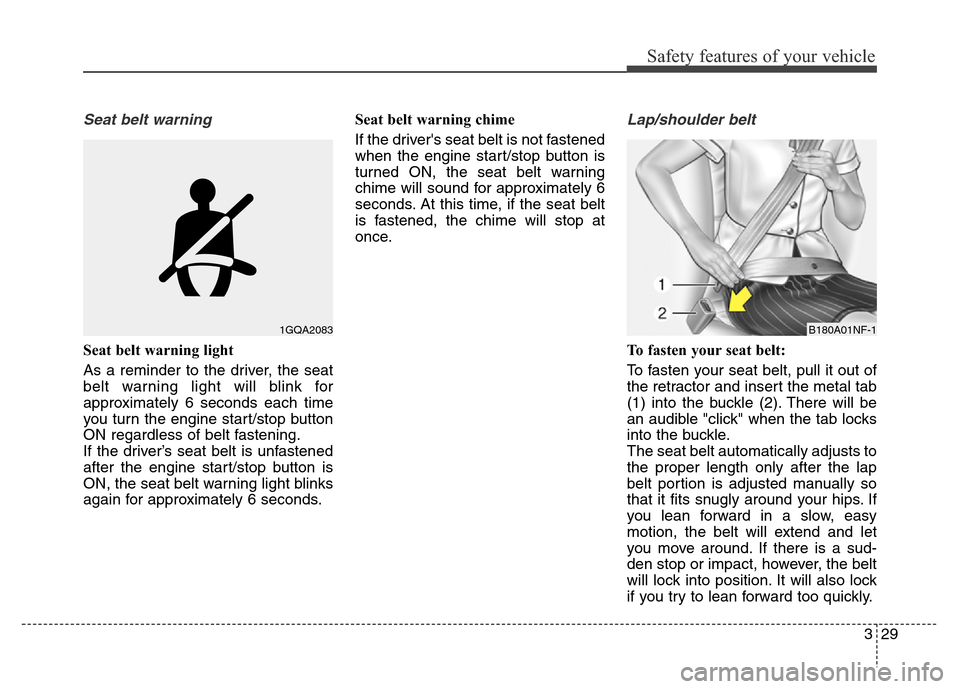
329
Safety features of your vehicle
Seat belt warning
Seat belt warning light
As a reminder to the driver, the seat
belt warning light will blink for
approximately 6 seconds each time
you turn the engine start/stop button
ON regardless of belt fastening.
If the driver’s seat belt is unfastened
after the engine start/stop button is
ON, the seat belt warning light blinks
again for approximately 6 seconds.Seat belt warning chime
If the driver's seat belt is not fastened
when the engine start/stop button is
turned ON, the seat belt warning
chime will sound for approximately 6
seconds. At this time, if the seat belt
is fastened, the chime will stop at
once.
Lap/shoulder belt
To fasten your seat belt:
To fasten your seat belt, pull it out of
the retractor and insert the metal tab
(1) into the buckle (2). There will be
an audible "click" when the tab locks
into the buckle.
The seat belt automatically adjusts to
the proper length only after the lap
belt portion is adjusted manually so
that it fits snugly around your hips. If
you lean forward in a slow, easy
motion, the belt will extend and let
you move around. If there is a sud-
den stop or impact, however, the belt
will lock into position. It will also lock
if you try to lean forward too quickly.
1GQA2083B180A01NF-1
Page 55 of 479
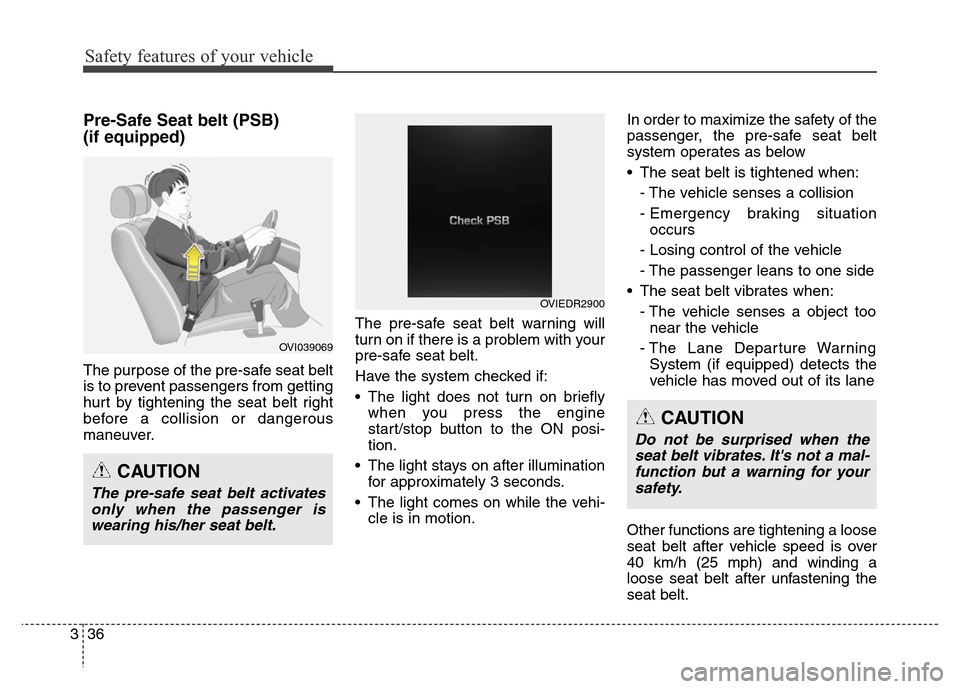
Safety features of your vehicle
36 3
Pre-Safe Seat belt (PSB)
(if equipped)
The purpose of the pre-safe seat belt
is to prevent passengers from getting
hurt by tightening the seat belt right
before a collision or dangerous
maneuver.The pre-safe seat belt warning will
turn on if there is a problem with your
pre-safe seat belt.
Have the system checked if:
• The light does not turn on briefly
when you press the engine
start/stop button to the ON posi-
tion.
• The light stays on after illumination
for approximately 3 seconds.
• The light comes on while the vehi-
cle is in motion.In order to maximize the safety of the
passenger, the pre-safe seat belt
system operates as below
• The seat belt is tightened when:
- The vehicle senses a collision
- Emergency braking situation
occurs
- Losing control of the vehicle
- The passenger leans to one side
• The seat belt vibrates when:
- The vehicle senses a object too
near the vehicle
- The Lane Departure Warning
System (if equipped) detects the
vehicle has moved out of its lane
Other functions are tightening a loose
seat belt after vehicle speed is over
40 km/h (25 mph) and winding a
loose seat belt after unfastening the
seat belt.
OVI039069
OVIEDR2900
CAUTION
The pre-safe seat belt activates
only when the passenger is
wearing his/her seat belt.
CAUTION
Do not be surprised when the
seat belt vibrates. It's not a mal-
function but a warning for your
safety.
Page 70 of 479
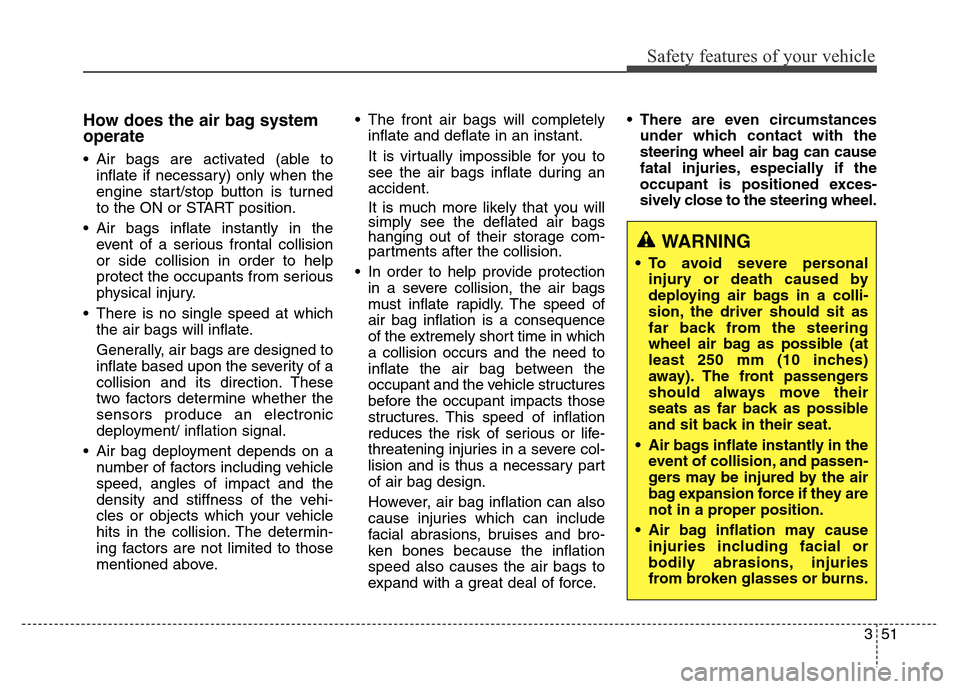
351
Safety features of your vehicle
How does the air bag system
operate
• Air bags are activated (able to
inflate if necessary) only when the
engine start/stop button is turned
to the ON or START position.
• Air bags inflate instantly in the
event of a serious frontal collision
or side collision in order to help
protect the occupants from serious
physical injury.
• There is no single speed at which
the air bags will inflate.
Generally, air bags are designed to
inflate based upon the severity of a
collision and its direction. These
two factors determine whether the
sensors produce an electronic
deployment/ inflation signal.
• Air bag deployment depends on a
number of factors including vehicle
speed, angles of impact and the
density and stiffness of the vehi-
cles or objects which your vehicle
hits in the collision. The determin-
ing factors are not limited to those
mentioned above.• The front air bags will completely
inflate and deflate in an instant.
It is virtually impossible for you to
see the air bags inflate during an
accident.
It is much more likely that you will
simply see the deflated air bags
hanging out of their storage com-
partments after the collision.
• In order to help provide protection
in a severe collision, the air bags
must inflate rapidly. The speed of
air bag inflation is a consequence
of the extremely short time in which
a collision occurs and the need to
inflate the air bag between the
occupant and the vehicle structures
before the occupant impacts those
structures. This speed of inflation
reduces the risk of serious or life-
threatening injuries in a severe col-
lision and is thus a necessary part
of air bag design.
However, air bag inflation can also
cause injuries which can include
facial abrasions, bruises and bro-
ken bones because the inflation
speed also causes the air bags to
expand with a great deal of force.• There are even circumstances
under which contact with the
steering wheel air bag can cause
fatal injuries, especially if the
occupant is positioned exces-
sively close to the steering wheel.
WARNING
• To avoid severe personal
injury or death caused by
deploying air bags in a colli-
sion, the driver should sit as
far back from the steering
wheel air bag as possible (at
least 250 mm (10 inches)
away). The front passengers
should always move their
seats as far back as possible
and sit back in their seat.
• Air bags inflate instantly in the
event of collision, and passen-
gers may be injured by the air
bag expansion force if they are
not in a proper position.
• Air bag inflation may cause
injuries including facial or
bodily abrasions, injuries
from broken glasses or burns.
Page 72 of 479
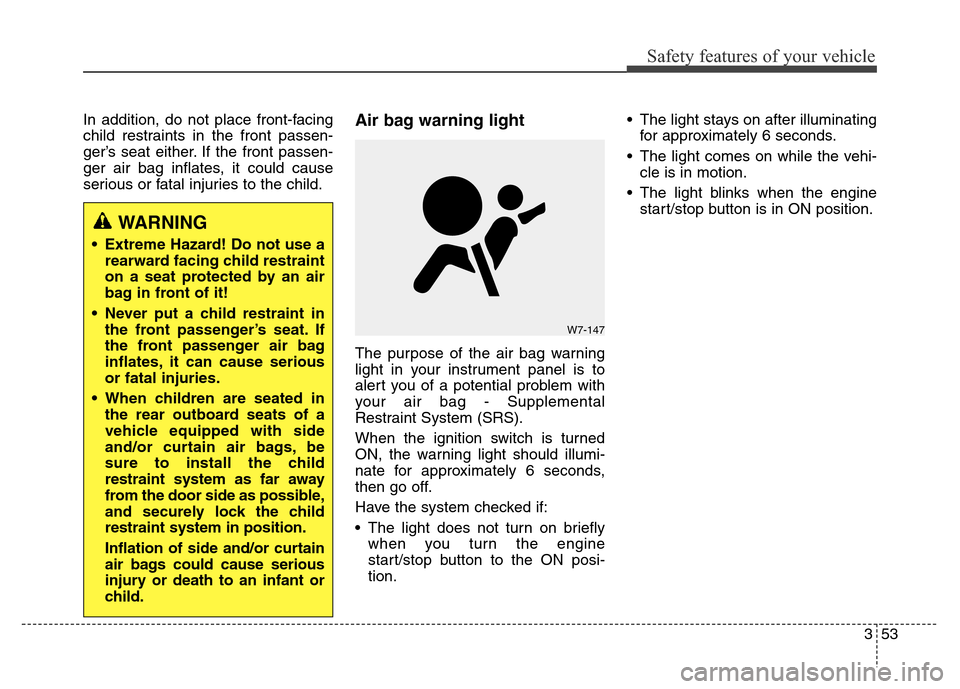
353
Safety features of your vehicle
In addition, do not place front-facing
child restraints in the front passen-
ger’s seat either. If the front passen-
ger air bag inflates, it could cause
serious or fatal injuries to the child.Air bag warning light
The purpose of the air bag warning
light in your instrument panel is to
alert you of a potential problem with
your air bag - Supplemental
Restraint System (SRS).
When the ignition switch is turned
ON, the warning light should illumi-
nate for approximately 6 seconds,
then go off.
Have the system checked if:
• The light does not turn on briefly
when you turn the engine
start/stop button to the ON posi-
tion.• The light stays on after illuminating
for approximately 6 seconds.
• The light comes on while the vehi-
cle is in motion.
• The light blinks when the engine
start/stop button is in ON position.
WARNING
• Extreme Hazard! Do not use a
rearward facing child restraint
on a seat protected by an air
bag in front of it!
• Never put a child restraint in
the front passenger’s seat. If
the front passenger air bag
inflates, it can cause serious
or fatal injuries.
• When children are seated in
the rear outboard seats of a
vehicle equipped with side
and/or curtain air bags, be
sure to install the child
restraint system as far away
from the door side as possible,
and securely lock the child
restraint system in position.
Inflation of side and/or curtain
air bags could cause serious
injury or death to an infant or
child.
W7-147